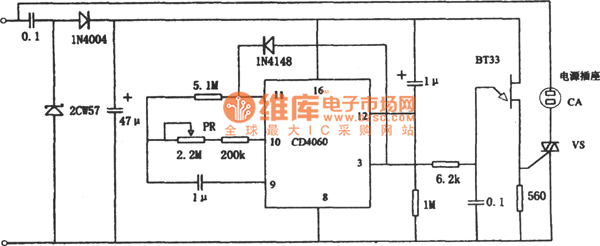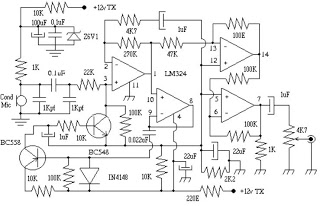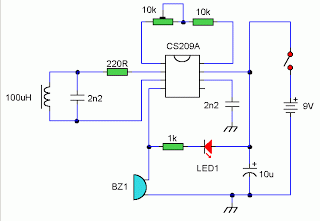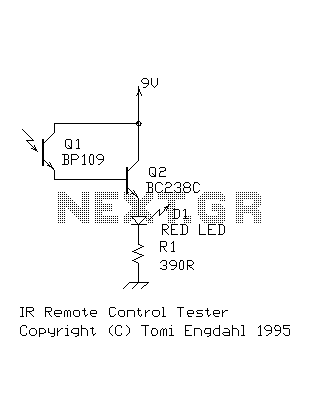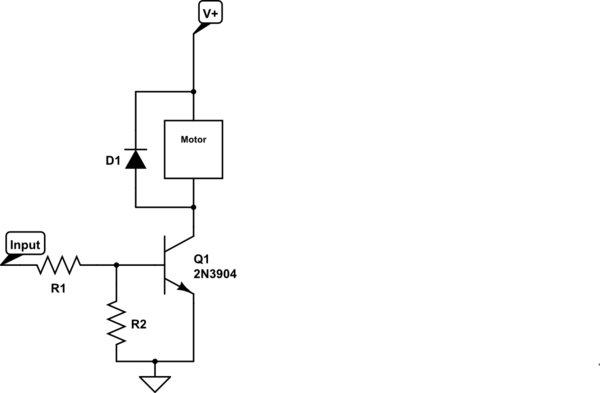
A Bedside Lamp Timer Circuit Schematic
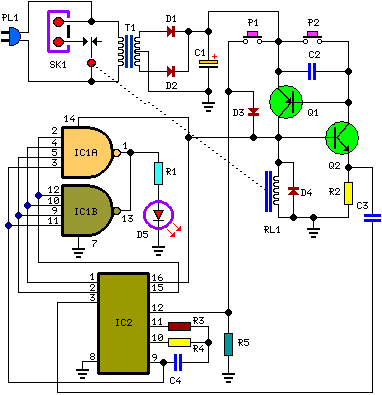
The purpose of this circuit is to power a lamp or other appliance for a specified duration (30 minutes in this case) and then automatically turn it off. This functionality is particularly useful for reading in bed at night, as it allows the bedside lamp to turn off automatically if the reader falls asleep. After activation via the P1 pushbutton, the LED illuminates for approximately 25 minutes. Subsequently, it begins to blink for two minutes, stops blinking for another two minutes, and then blinks again for two minutes before the lamp is switched off, signaling the impending end of the on-time. If the user wishes to extend the reading time, an additional half-hour of light can be obtained by pressing P1 again. The lamp can be turned off at the user's discretion by pressing P2. Transistors Q1 and Q2 form an ALL-ON ALL-OFF circuit that draws minimal current in the off state. The activation of the circuit begins with P1, which energizes the relay and powers the two integrated circuits (ICs). The lamp is controlled by the relay switch, and IC2 is reset with a positive voltage applied to pin 12. IC2 starts oscillating at a frequency determined by the resistor R4 and capacitor C4. With the specified component values, pin 3 goes high after about 30 minutes, deactivating the circuit via capacitor C3. During the six minutes leading up to the turn-off, the LED blinks due to the connections from IC1 to pins 1, 2, and 15 of IC2. The blinking frequency is generated by the oscillator in IC2 at pin 9. The two gates of IC1 are configured in parallel to provide increased current output. Additionally, a piezo sounder can be connected to pins 1 and 14 of IC1 if desired. It is important to note that the timing can be adjusted by changing the values of capacitor C4 and/or resistor R4.
The circuit operates primarily through the interaction of two integrated circuits, a relay, and a few passive components. The P1 pushbutton initiates the operation by applying power to the system, which triggers the relay to engage and subsequently powers the lamp. The LED serves as a visual indicator of the circuit's status, illuminating continuously during the initial 25 minutes and then entering a blinking mode to alert the user that the time is about to expire. The oscillation frequency of IC2 is critical for defining the timing intervals, with the resistor-capacitor (RC) timing network composed of R4 and C4 determining the overall duration of the lamp's operation.
The blinking pattern is a crucial feature, providing a clear signal to the user that the lamp will soon turn off, thus preventing abrupt darkness. The implementation of the ALL-ON ALL-OFF circuit using transistors Q1 and Q2 ensures that the system remains energy-efficient when not in use. The ability to extend the reading time by pressing P1 again offers convenience and flexibility to the user, while the option to turn off the lamp using P2 ensures user control over the device.
For further customization, the addition of a piezo sounder can enhance the user experience by providing audible alerts in conjunction with the visual LED signals. Adjustments to the timing can be made by selecting different values for R4 and C4, allowing for a tailored operation to suit individual preferences. Overall, this circuit is a practical solution for automating the control of a bedside lamp, enhancing comfort and usability for nighttime reading activities.The purpose of this circuit is to power a lamp or other appliance for a given time (30 minutes in this case), and then to turn it off. It is useful when reading at bed by night, turning off the bedside lamp automatically in case the reader falls asleep After turn-on by P1 pushbutton, the LED illuminates for around 25 minutes, but then it starts
to blink for two minutes, stops blinking for two minutes and blinks for another two just before switching the lamp off, thus signaling that the on-time is ending. If the user want to prolong the reading, he/she can earn another half-hour of light by pushing on P1.
Turning-off the lamp at user`s ease is obtained by pushing on P2. Q1 and Q2 form an ALL-ON ALL-OFF circuit that in the off state draws no significant current. P1 starts the circuit, the relay is turned on and the two ICs are powered. The lamp is powered by the relay switch, and IC2 is reset with a positive voltage at pin 12. IC2 starts oscillating at a frequency set by R4 and C4. With the values shown, pin 3 goes high after around 30 minutes, turning off the circuit via C3. During the c6 minutes preceding turn-off. The LED does a blinking action by connections of IC1 to pins 1, 2 & 15 of IC2. Blinking frequency is provided by IC2 oscillator at pin 9. The two gates of IC1 are wired in parallel to source more current. If required, a piezo sounder can be connected to pins 1 & 14 of IC1. Obviously, timings can be varied changing C4 and/or R4 values. 🔗 External reference
The circuit operates primarily through the interaction of two integrated circuits, a relay, and a few passive components. The P1 pushbutton initiates the operation by applying power to the system, which triggers the relay to engage and subsequently powers the lamp. The LED serves as a visual indicator of the circuit's status, illuminating continuously during the initial 25 minutes and then entering a blinking mode to alert the user that the time is about to expire. The oscillation frequency of IC2 is critical for defining the timing intervals, with the resistor-capacitor (RC) timing network composed of R4 and C4 determining the overall duration of the lamp's operation.
The blinking pattern is a crucial feature, providing a clear signal to the user that the lamp will soon turn off, thus preventing abrupt darkness. The implementation of the ALL-ON ALL-OFF circuit using transistors Q1 and Q2 ensures that the system remains energy-efficient when not in use. The ability to extend the reading time by pressing P1 again offers convenience and flexibility to the user, while the option to turn off the lamp using P2 ensures user control over the device.
For further customization, the addition of a piezo sounder can enhance the user experience by providing audible alerts in conjunction with the visual LED signals. Adjustments to the timing can be made by selecting different values for R4 and C4, allowing for a tailored operation to suit individual preferences. Overall, this circuit is a practical solution for automating the control of a bedside lamp, enhancing comfort and usability for nighttime reading activities.The purpose of this circuit is to power a lamp or other appliance for a given time (30 minutes in this case), and then to turn it off. It is useful when reading at bed by night, turning off the bedside lamp automatically in case the reader falls asleep After turn-on by P1 pushbutton, the LED illuminates for around 25 minutes, but then it starts
to blink for two minutes, stops blinking for two minutes and blinks for another two just before switching the lamp off, thus signaling that the on-time is ending. If the user want to prolong the reading, he/she can earn another half-hour of light by pushing on P1.
Turning-off the lamp at user`s ease is obtained by pushing on P2. Q1 and Q2 form an ALL-ON ALL-OFF circuit that in the off state draws no significant current. P1 starts the circuit, the relay is turned on and the two ICs are powered. The lamp is powered by the relay switch, and IC2 is reset with a positive voltage at pin 12. IC2 starts oscillating at a frequency set by R4 and C4. With the values shown, pin 3 goes high after around 30 minutes, turning off the circuit via C3. During the c6 minutes preceding turn-off. The LED does a blinking action by connections of IC1 to pins 1, 2 & 15 of IC2. Blinking frequency is provided by IC2 oscillator at pin 9. The two gates of IC1 are wired in parallel to source more current. If required, a piezo sounder can be connected to pins 1 & 14 of IC1. Obviously, timings can be varied changing C4 and/or R4 values. 🔗 External reference
